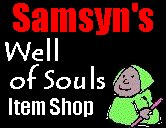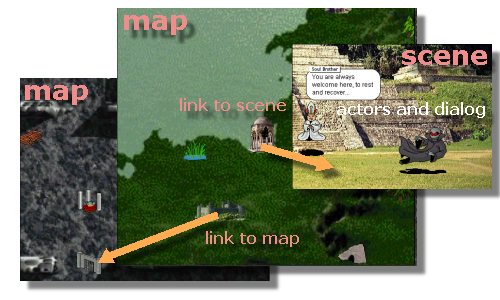
WoS World
Developer Pages
Story and Place
Home Page
Community:
Bulletin Board
WorldDev Forum
Developer Pages:
Overview
Story and Place
Heroes and
Monsters
Items, Weapons
& Spells
Music and SFX
Non-linear
Storytelling
The 'Quest'
Language
Publishing Your
World
Developers:
Custom Skins
Other Worlds
Author's_Guidelines
Art_Submission
Beta Testers Page
Development_Notes
| Your World is a
Place That People Can Visit Probably more than anything else, your world is a location (hopefully a bunch of locations) and should offer the player sufficient sight-seeing opportunities to maintain their interest. Even without monsters or quests, people can still travel your world and explore its scenic vistas, alone or with friends. While you might be the sort of person who enjoys planning every detail of your world before creating it's first asset, the geography of your world should still be the first part that you implement. Your world's geography consists of three key elements:
You use the graphics program of your choice to craft JPEG files, and the Link Editor to wire your maps and scenes together.
You will need one map right away, your World Map which shows your entire world. Of course, it's probably best if you think it all out first, but you could start with a placeholder graphic and change it later, if you like. This world map will be used at the start of the game to set the player's mood. A world map should be on the order of 768 pixels wide and/or tall. (The larger your map is, the slower it will load). Players walk across your map and drop through link points if they stop upon them. If the link is to another map, they appear to walk out of a link point on that map. If the link is to a scene, the view changes to the side-view and they can have an interaction with an actor or two. Generally, when they leave a scene, they will return to the map near the link point which took them into that scene. There are two other ways of entering a scene from the map. The player can camp, which is simply a way to drop into a scene for conversation with other players, or to cast spells upon themselves. Or, the player can be pulled into a monster fight scene whether they were expecting it or not. In addition to 'gluing the world together,' link points have many other properties. For example a link point defines the background scene JPEG to be used when the player camps or fights in that part of the map, what music should play in the background, whether or not there are monsters near that link, and which Quest Language scene script should be executed if the link is to a scene. Which ever link point is closest to the player (no matter how far away it might be) controls these extra properties. You set the properties of each link point by using the Link Editor. |
| Your World is a
Place Where Things have Happened But more than just scenery, your world has a story, a history, and (with the player's help) a future. You tell the story of your world through the names of its locations and people, the dialog with non-player characters (actors), and the nature of the opportunities you provide the players. When the player first enters your world, they are greeted with an attractive zooming map (your world map) upon which is a scrolling Back Story (which you define in your quest.txt file). This is almost your only chance to deliver a linear story, so set the mood and give the player their first clues as to what they need to do. Once this introduction has finished (or the player dimisses it prematurely), the player is taken scene 0 (zero, every scene is identified by a scene number). This is where they pick their starting character, or an old character to resume. This is called "The Well" though you can try to change the metaphor to meet the needs of your world. When the player has organized their character, they must press the Incarnate button to actually enter your world and begin playing. For an old character, this will take them to the last link point visited by that character. For a new character, they will be taken to just outside of link-point 0 (each link point on a map is numbered) of map 0 (each map in your world is numbered, and zero is always the main world map). They cannot return to the well simply by stepping on a link-point. They must press the Return To Well button, which saves their current character's position and then returns them to scene 0 where they can pick a different character with which to continue. As the player walks the map, they will encounter your other link-points for that map, which should take them, on occasion, into scenes which run specific Quest Language scripts (a simple programming language) that informs them of quests, gives hints, gives rewards, etc. You will create actors (NPCs - Non Player Characters) with colorful histories and problems, and the players will help your actors fulfill their dreams. To help you keep track of what an individual player character has already done, your scene scripts will give the player invisible tokens and later check for their presence. For example, one token might mean "I already told the player that I need the Key of Flame" while another might mean "The player already gave me the Key of Flame." By checking these tokens, you can decide what should happen next in your scene. In this way, what happens in a particular scene can change depending on what the player has done before visiting it each time. Tokens are just numbers (your world can have thousands of tokens), but you can also associate a short sentence with each token. If you do, then that sentence will appear in the player's Quest Diary and should be used both to praise them for accomplishments, and remind them of hints they may have received but not yet followed through on. Since these token sentences are listed in numeric order, you should organize your tokens to make sense. To allow for future fiddling, I generally leave myself room for ten tokens per quest (more for a complex quest). So the first token of one quest might be 40, while the first token of another quest is 50. That way I have room to use a couple more tokens in "quest 40" and still have them appear next to each other in the Quest Diary (instead of having hints from quest 40 appear interspersed with other quest hints). Of course, that might be exactly what you want to have happen, so it's your choice. Most of your story-telling will be through the use of actor dialog. You might have several actors in a scene, chatting back and forth in front of the player. Perhaps moving around a bit in the scene. You can have additional actors enter and exit, and even start a scripted FIGHT scene with a particular group of monsters before continuing the scene script. To a limited degree, your actors can also ask questions of the player and evaluate the player's response, setting appropriate tokens as a result. But remember: the player can enter your scenes in almost any order, so you must make proper use of tokens to avoid telling too much of your story too soon, or leaving out important information. This ability of the player to encounter your story from many different directions is called Nonlinear Storytelling. A book is a form of linear storytelling, since most people read one page after the other. A nonlinear story is more like a web site, where people can click on hyperlinks in any order they like. You can edit your world's scene scripts by using any text editor, including the Quest Editor. When crafting actor dialog, you'll want to keep your sentences short, since there is a limited amount of room on the screen for chat bubbles. Break your concepts up into many short sentences, delivered by several actors, to keep the player's interest. The sentences will also be recorded to the chat window, so the player can easily scroll back and read anything they missed. |
